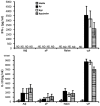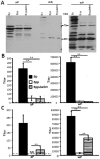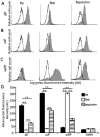O antigen allows B. parapertussis to evade B. pertussis vaccine-induced immunity by blocking binding and functions of cross-reactive antibodies
- PMID: 19750010
- PMCID: PMC2737124
- DOI: 10.1371/journal.pone.0006989
O antigen allows B. parapertussis to evade B. pertussis vaccine-induced immunity by blocking binding and functions of cross-reactive antibodies
Abstract
Although the prevalence of Bordetella parapertussis varies dramatically among studies in different populations with different vaccination regimens, there is broad agreement that whooping cough vaccines, composed only of B. pertussis antigens, provide little if any protection against B. parapertussis. In C57BL/6 mice, a B. pertussis whole-cell vaccine (wP) provided modest protection against B. parapertussis, which was dependent on IFN-gamma. The wP was much more protective against an isogenic B. parapertussis strain lacking O-antigen than its wild-type counterpart. O-antigen inhibited binding of wP-induced antibodies to B. parapertussis, as well as antibody-mediated opsonophagocytosis in vitro and clearance in vivo. aP-induced antibodies also bound better in vitro to the O-antigen mutant than to wild-type B. parapertussis, but aP failed to confer protection against wild-type or O antigen-deficient B. parapertussis in mice. Interestingly, B. parapertussis-specific antibodies provided in addition to either wP or aP were sufficient to very rapidly reduce B. parapertussis numbers in mouse lungs. This study identifies a mechanism by which one pathogen escapes immunity induced by vaccination against a closely related pathogen and may explain why B. parapertussis prevalence varies substantially between populations with different vaccination strategies.
Conflict of interest statement
Figures










Similar articles
-
The O antigen enables Bordetella parapertussis to avoid Bordetella pertussis-induced immunity.Infect Immun. 2007 Oct;75(10):4972-9. doi: 10.1128/IAI.00763-07. Epub 2007 Aug 13. Infect Immun. 2007. PMID: 17698566 Free PMC article.
-
A recombinant iron transport protein from Bordetella pertussis confers protection against Bordetella parapertussis.Microbiol Immunol. 2017 Oct;61(10):407-415. doi: 10.1111/1348-0421.12532. Epub 2017 Sep 26. Microbiol Immunol. 2017. PMID: 28857261
-
Outer membrane vesicles derived from Bordetella parapertussis as an acellular vaccine against Bordetella parapertussis and Bordetella pertussis infection.Vaccine. 2013 Oct 25;31(45):5262-8. doi: 10.1016/j.vaccine.2013.08.059. Epub 2013 Sep 5. Vaccine. 2013. PMID: 24012570
-
Bordetella pertussis, B. parapertussis, vaccines and cycles of whooping cough.Pathog Dis. 2015 Oct;73(7):ftv055. doi: 10.1093/femspd/ftv055. Epub 2015 Aug 4. Pathog Dis. 2015. PMID: 26242280 Review.
-
Development of improved pertussis vaccine.Hum Vaccin Immunother. 2014;10(8):2450-3. doi: 10.4161/hv.29253. Hum Vaccin Immunother. 2014. PMID: 25424954 Free PMC article. Review.
Cited by
-
Pertussis Vaccines Scarcely Provide Protection against Bordetella parapertussis Infection in Children-A Systematic Review and Meta-Analysis.Vaccines (Basel). 2024 Feb 28;12(3):253. doi: 10.3390/vaccines12030253. Vaccines (Basel). 2024. PMID: 38543887 Free PMC article. Review.
-
Enhancement of immune response against Bordetella spp. by disrupting immunomodulation.Sci Rep. 2019 Dec 30;9(1):20261. doi: 10.1038/s41598-019-56652-z. Sci Rep. 2019. PMID: 31889098 Free PMC article.
-
Decreased leukocyte accumulation and delayed Bordetella pertussis clearance in IL-6-/- mice.J Immunol. 2011 Apr 15;186(8):4895-904. doi: 10.4049/jimmunol.1000594. Epub 2011 Mar 11. J Immunol. 2011. PMID: 21398615 Free PMC article.
-
Lack of cross-protection against Bordetella holmesii after pertussis vaccination.Emerg Infect Dis. 2012 Nov;18(11):1771-9. doi: 10.3201/eid1811.111544. Emerg Infect Dis. 2012. PMID: 23092514 Free PMC article.
-
The O antigen is a critical antigen for the development of a protective immune response to Bordetella parapertussis.Infect Immun. 2009 Nov;77(11):5050-8. doi: 10.1128/IAI.00667-09. Epub 2009 Sep 8. Infect Immun. 2009. PMID: 19737902 Free PMC article.
References
-
- Cherry JD, Brunell PA, Golden GS, Karson DT. Report of the task force on pertussis and pertussis immunization-1988. Pediatrics. 1988;81
-
- From the Centers for Disease Control and Prevention. Pertussis–United States, 1997-2000. JAMA. 2002;287:977–979. - PubMed
-
- Celentano LP , M M, Paramatti D, Salmaso S Tozzi AEEUVAC-NET Group. Resurgence of pertussis in Europe. Pediatr Infect Dis J. 2005;24:761–765. - PubMed
-
- de Melker HE , V F, Schellekens JF, Teunis PF, Kretzschmar M. The incidence of Bordetella pertussis infections estimated in the population from a combination of serological surveys. J Infect. 2006;53:106–113. - PubMed
Publication types
MeSH terms
Substances
Grants and funding
LinkOut - more resources
Full Text Sources
Other Literature Sources

